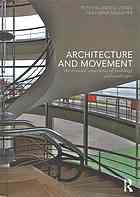(Ebook) Architecture and movement - The dynamic experience of buildings and landscapes by Nishat Awan, Peter Blundell-Jones, Mark Meagher ISBN 9780415725347, 9780415725354, 9781315764771, 0415725348, 0415725356, 1315764776
"The experience of movement, of moving through buildings, cities, landscapes and in everyday life, is the only involvement most individuals have with the built environment on a daily basis. Yet this concept of user experience is so often neglected in architectural study and practice. This book tackles this complex subject for the first time, providing the wide range of perspectives needed to tackle this multi-disciplinary topic. Organised in four parts it:documents the architect's, planner's, or designer's approach, looking at how they have sought to deploy buildings as a promenade and how they have thought or written about it. concentrates on the individual's experience, and particularly on the primacy of walking, which engages other senses besides the visual. engages with society and social rituals, and how mutually we define the spaces through which we move, both by laying out routes and boundaries and by celebrating thresholds. analyses how we deal with promenades which are not experienced directly but via other mediums such as computer models, drawings, film and television. The wide selection of contributors include academics and practitioners and discuss cases from across the US, UK, Europe and Asia. By mingling such disparate voices in a carefully curated selection of chapters, the book enlarges the understanding of architects, architectural students, designers and planners, alerting them to the many and complex issues involved in the experience of movement."-Part 1: Moving through Buildings and Landscapes: the Designer's Perspective 1.0 Introduction to Part One 1.1 The Classical Authors 1.2 Viollet-le-duc on the Medieval Cloister 1.3 Charles Garnier Le Théâtre 1.4 Hermann Muthesius Wie baue ich mein Haus 1.5 Architectural Promenades through the Villa Savoye 1.6 Gunnar Asplund: 'Pictures with marginal notes from the Gothenburg art and industry exhibition' 1923 1.7 Frank Lloyd Wright's Use of Movement 1.8 Hans Scharoun and Movement: the Kassel Project 1952 1.9 Move to the Light 1.10 Odysseus and Kalypso -- at home Part 2: Movement as Experienced by the Individual 2.0 Introduction to Part Two 2.1 The Primacy of Bodily Experience 2.2 From Health to Pleasure: the Landscape of Walking 2.3 Architecture of Walking 2.4 Soundscape and Movement 2.5 From Foot to Vehicle 2.6 Moving Round the Ring-Road 2.7 The Geometry of Moving Bodies 2.8 Pedestrians and Traffic Part 3: Movement as Social and Shared 3.0 Introduction to Part Three 3.1 Space as a Product of Bodily Movement: Centre, Path and Threshold 3.2 Rievaulx and the Order of St Benedict 3.3 Lucien Kroll The Architecture of Complexity, The Door 3.4 The Japanese Tea Ceremony 3.5 The East Royal Tombs of the Qing Dynasty 3.6 The Automated Gardens of Lunéville: From the Self-Moving Landscape to the Circuit Walk 3.7 Lauriston School Part 4: The Representation of Movement 4.0 Introduction to Part Four 4.1 House Construction among the Dong 4.2 Movement and the Use of the Sequential Section by Enric Miralles and Mathur and da Cunha 4.3 From Models to Movement: Reflections on Some Recent Projects by Herzog et de Meuron 4.4 An Encounter With Patrick Keiller 4.5 Diasporic Experience and the Need for Topological Methods 4.6 Open Design: Thoughts on Software and the Representation of Movement 4.7 The Matter of Movement.
*Free conversion of into popular formats such as PDF, DOCX, DOC, AZW, EPUB, and MOBI after payment.


